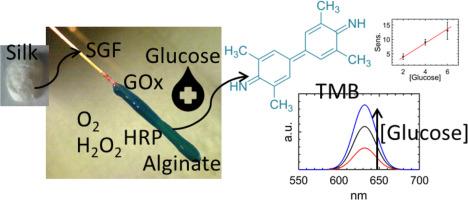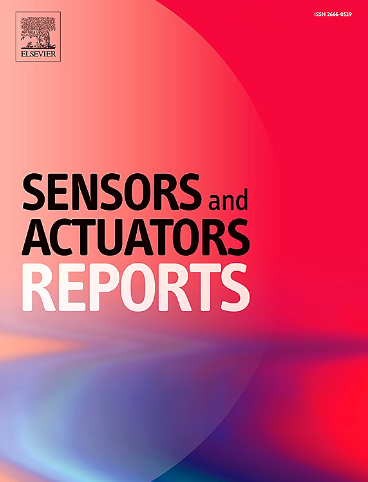Silkworm gut fibre-based biosensors for optical glucose detection
IF 7.6
Q1 BIOTECHNOLOGY & APPLIED MICROBIOLOGY
引用次数: 0
Abstract
Silk is a re-emerging biomaterial with significant potential for optical waveguiding due to its high transparency in the visible spectrum and elevated refractive index. Naturally occurring silk filamentous structures, such as silkworm gut fibres (SGFs), resemble traditional optical fibres while offering advantages such as biocompatibility, flexibility, mechanical strength and biodegradability. In this study, SGFs from different Bombyx mori races were evaluated for their suitability in optical fibre-based biosensing applications. White SGFs were selected for their superior optical properties, including a broad transmission window in the visible spectrum, strong light confinement, and high guidance efficiency. However, pristine SGFs exhibited sensitivity to hydration/drying cycles, leading to transmission losses. To address this, an alginate cladding was applied, stabilizing the fibre while preserving biocompatibility and optical performance. The modified SGFs successfully quantified colorants in the surrounding medium and were further employed in biochemical sensing. Specifically, alginate-coated SGFs enabled glucose detection by monitoring the colorimetric response of a redox mediator oxidized through a bi-enzymatic reaction involving glucose oxidase and peroxidase. This system effectively distinguished glucose concentrations corresponding to healthy, hypoglycaemic, and hyperglycaemic (pre-diabetic and diabetic) conditions. Furthermore, direct glucose measurements in real blood samples were possible, as the alginate layer functioned as a size-exclusion filter, selectively retaining cellular components while allowing glucose to diffuse and react with immobilized enzymes and redox mediators. The use of silk and alginate, both recognised as biodegradable materials, suggests significant potential for the development of real-time, minimally invasive glucose monitoring systems for in vitro and in vivo analysis.

用于光学葡萄糖检测的蚕肠纤维生物传感器
丝是一种新兴的生物材料,由于其在可见光谱中的高透明度和高折射率,具有重要的光波导潜力。天然存在的丝状结构,如蚕肠纤维(SGFs),类似于传统的光纤,同时具有生物相容性、柔韧性、机械强度和生物降解性等优点。在这项研究中,我们对不同家蚕品种的sgf在基于光纤的生物传感应用中的适用性进行了评估。选择白色SGFs是因为其优越的光学特性,包括在可见光谱中具有宽的透射窗口,强光约束和高制导效率。然而,原始SGFs对水化/干燥循环表现出敏感性,导致传输损失。为了解决这个问题,应用了海藻酸盐包层,在保持生物相容性和光学性能的同时稳定了纤维。改进的SGFs成功地定量了周围介质中的着色剂,并进一步应用于生化传感。具体来说,海藻酸盐包被的SGFs通过监测氧化还原介质通过涉及葡萄糖氧化酶和过氧化物酶的双酶反应氧化的比色反应来实现葡萄糖检测。该系统有效地区分了健康、低血糖和高血糖(糖尿病前期和糖尿病)状态下的葡萄糖浓度。此外,在真实血液样本中直接测量葡萄糖是可能的,因为海藻酸盐层作为尺寸排除过滤器,选择性地保留细胞成分,同时允许葡萄糖扩散并与固定化酶和氧化还原介质发生反应。蚕丝和海藻酸盐都被认为是可生物降解的材料,它们的使用表明,用于体外和体内分析的实时、微创血糖监测系统的开发具有巨大的潜力。
本文章由计算机程序翻译,如有差异,请以英文原文为准。
求助全文
约1分钟内获得全文
求助全文
来源期刊

Sensors and Actuators Reports
Multiple-
CiteScore
9.60
自引率
0.00%
发文量
60
审稿时长
49 days
期刊介绍:
Sensors and Actuators Reports is a peer-reviewed open access journal launched out from the Sensors and Actuators journal family. Sensors and Actuators Reports is dedicated to publishing new and original works in the field of all type of sensors and actuators, including bio-, chemical-, physical-, and nano- sensors and actuators, which demonstrates significant progress beyond the current state of the art. The journal regularly publishes original research papers, reviews, and short communications.
For research papers and short communications, the journal aims to publish the new and original work supported by experimental results and as such purely theoretical works are not accepted.
 求助内容:
求助内容: 应助结果提醒方式:
应助结果提醒方式:


